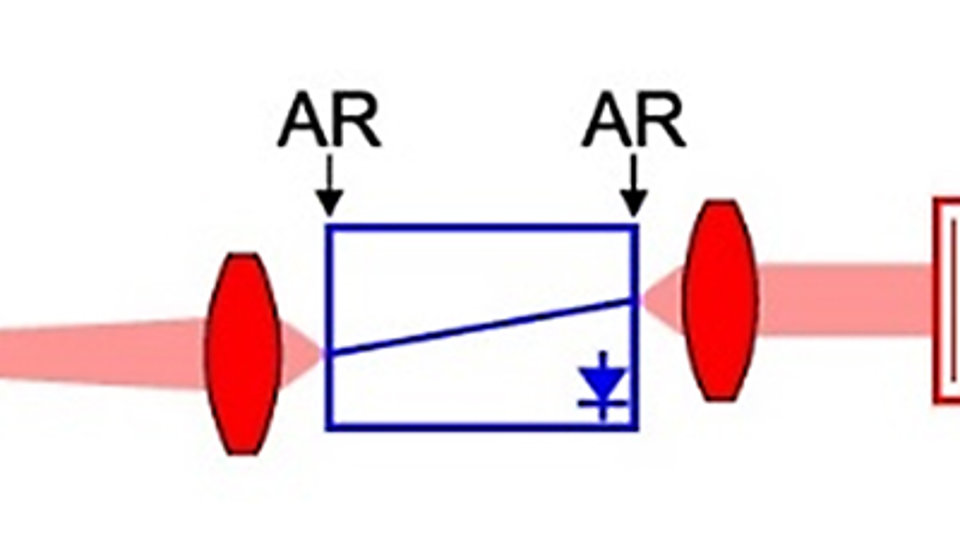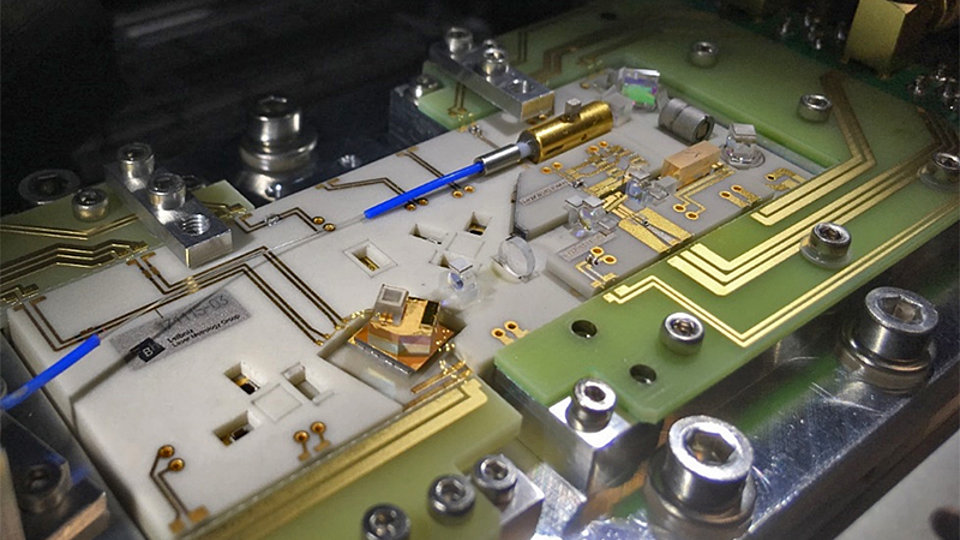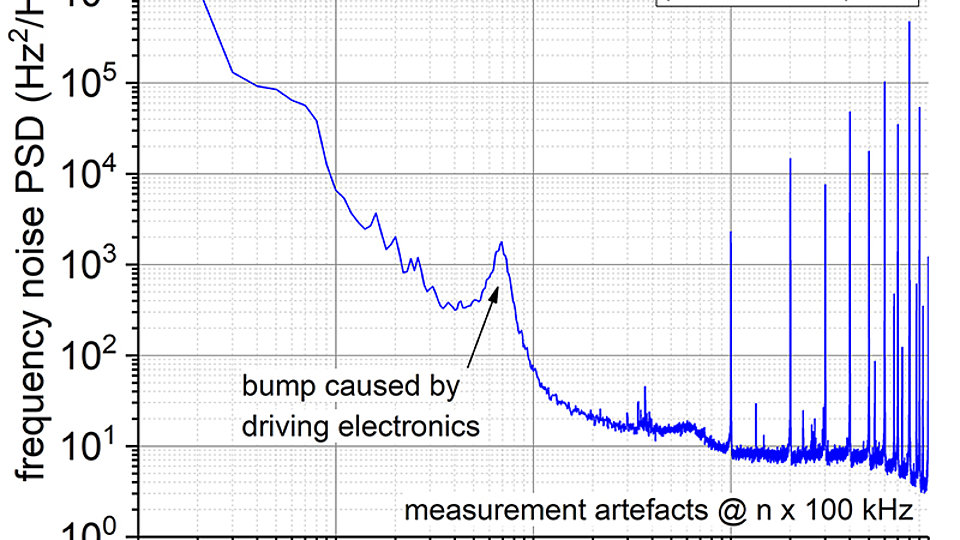Ultra-narrow linewidth diode laser for LISA
Fig. 1: Principle setup of the diode laser with resonant optical feedback consisting of an external cavity (Cav), a semiconductor gain chip with AR coating on both facets, and a VHBG
Fig. 2: Micro-integrated ultra-narrow linewidth diode laser based on resonant optical feedback (footprint of the AlN optical bench (light gray): 80 x 30 mm2
Laser Interferometer Space Antenna (LISA) is an upcoming satellite mission aiming to detect and characterize gravitational waves. For this purpose, changes in the distance between test masses on board three satellites that are spaced 2.5 million km apart need to be measured in the order of a few pm. This challenging mission shall be achieved by means of three laser interferometers, whose key elements are the so-called metrology lasers. Albeit amplified and stabilized in amplitude as well as in frequency, these lasers require very low-noise seed lasers. In previous studies, a Nd:YAG NPRO laser like the ones used for free-space optical satellite communication was selected as baseline for the seed laser.
As part of an ESA project, FBH has now developed a potential alternative seed laser which is based on a diode laser operating at 1064 nm with resonant optical feedback. The laser concept is illustrated in Fig. 1. The laser consists of an external cavity, a semiconductor gain chip with an AR coating on both facets, and a volume holographic Bragg grating (VHBG). This setup resembles a conventional extended cavity diode laser (ECDL) but with the external cavity replacing one of the mirrors. Here, the external cavity acts as a mirror and the resonant feedback is re-injected into the gain chip if the frequency of the ECDL part matches the resonance frequency of the external cavity. As the light travels back and forth inside the external cavity before feeding back to the gain chip, this setup effectively implements a very long cavity, but at the same time avoids problems related to very long conventional ECDL setups.
The ultra-narrow linewidth diode laser based on the described concept is micro-integrated on an AlN optical bench (footprint 80 x 30 mm2), which is part of FBH’s versatile hybrid integration technology platform for implementation of complex laser systems. This platform also provides the means to couple the emitted light into a polarization-maintaining optical fiber. The micro-integrated module is depicted in Fig. 2. Here, the semiconductor gain chip (on its submount) and the passive optical elements like external cavity, VHBG, lenses, wave plate, mirrors, optical isolator, thin film polarizer, and fiber collimator are adhesively bonded to the optical bench utilizing FBH’s established micro-integration process.
In order to assess the frequency stability of the laser module, the frequency noise power spectral density (PSD) of the laser was measured in a self-delayed heterodyne (SDH) setup with a delay line length of 2 km. The result is shown in Fig. 3. At Fourier frequencies below 10 kHz, the PSD exhibits a 1/f2 behavior. Such a slope is also common for a Nd:YAG NPRO. At the working point, the PSD of the laser module reaches a white noise floor of approximately 8 Hz2/Hz for Fourier frequencies above 100 kHz. This corresponds to a Lorentzian linewidth of 13 Hz.
Further, this laser module also allows for frequency tuning. As the resonance frequency of the external cavity determines the emission frequency of the entire laser, frequency tuning of the laser is achieved by tuning the resonance frequency of the external cavity. For coarse and slow frequency tuning this can be realized by means of the cavity temperature. In order to enable fast frequency tuning, the external cavity is made of LiNbO3. This allows for electro-optical tuning on timescales exceeding the capabilities of an Nd:YAG NPRO by several orders of magnitude. A locking algorithm ensuring that the optical length of the ECDL part follows this tuning was developed and verified.
In summary, we present a micro-integrated ultra-narrow linewidth diode laser module, which was developed in an activity aiming at a potential replacement of the Nd:YAG NPRO for the LISA mission. The module achieves a Lorentzian linewidth of 13 Hz. At the same time this module is capable of fast frequency tuning. Although the development of this specific laser was motivated by the requirements of the LISA mission, such a laser module is suitable for a variety of applications, as it also meets the requirements of, e.g., coherent optical communication applications.
A presentation of the results will be given at Photonics West 2019 in San Francisco.
This work was supported by the European Space Agency (ESA), Contract No. 4000119715/17/NL/BW.
Publications
K. Dahl, P. Cebeci, O. Fitzau, M. Giesberts, C. Greve, M. Krutzik, A. Peters, S. Amairi Pyka, J. Sanjuan, M. Schiemangk, T. Schuldt, K. Voss, and A. Wicht, "A New Laser Technology for LISA", Proc. International Conference on Space Optics - ICSO 2018 (2018).
H. Christopher, B. Arar, A. Bawamia, C. Kürbis, W. Lewoczko-Adamczyk, M. Schiemangk, R. Smol, A. Wicht, A. Peters, and Günther Tränkle, "Narrow linewidth micro-integrated high power diode laser module for deployment in space", Proc. 2017 IEEE International Conference on Space Optical Systems and Applications (ICSOS), 150 (2017).
A. Wicht, A. Bawamia, M. Krüger, Ch. Kürbis, M. Schiemangk, R. Smol, A. Peters, and G. Tränkle, "Narrow linewidth diode laser modules for quantum optical sensor applications in the field and in space", Proc. SPIE 10085, Photonics West, San Francisco, USA, Jan 28 - Feb 02, 100850F (2017)
W. Lewoczko-Adamczyk, C. Pyrlik, J. Häger, S. Schwertfeger, A. Wicht, A. Peters, G. Erbert, and G. Tränkle, "Ultra-narrow linewidth DFB-laser with optical feedback from a monolithic confocal Fabry-Pérot cavity", Opt. Express, 23, 9705 (2015)


